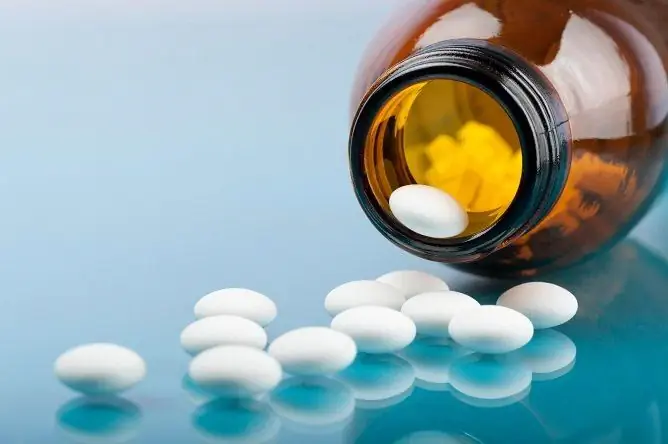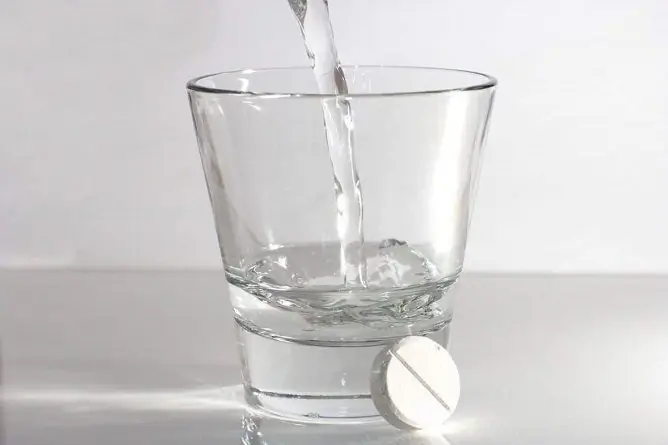- Author Rachel Wainwright [email protected].
- Public 2023-12-15 07:39.
- Last modified 2025-11-02 20:14.
Pressure pills for type 2 diabetes mellitus: drugs for hypertension with additional effects
The content of the article:
- What to drink to lower blood pressure with non-insulin dependent diabetes mellitus
- Arterial hypertension and non-insulin dependent diabetes mellitus
- Features of the course of arterial hypertension in type 2 diabetes mellitus
- Video
The question of which pressure pills for type 2 diabetes mellitus can be taken by patients is very relevant. This is due to the fact that the disease usually affects people of the middle and older age group, who already suffer from hypertension. In addition, high levels of glucose and insulin in the blood themselves trigger pathological mechanisms that contribute to an increase in blood pressure.

Drug therapy of hypertension in patients with diabetes mellitus has features
Type 2 diabetes mellitus (non-insulin dependent diabetes mellitus, NIDDM) is a chronic disease caused by relative insulin deficiency, i.e., a decrease in insulin sensitivity of receptors located in insulin-dependent tissues. Diabetes mellitus usually develops in people over 40 years of age. It is more often diagnosed in women.
What to drink to lower blood pressure with non-insulin dependent diabetes mellitus
Basically, in patients suffering from arterial hypertension on the background of diabetes mellitus, new effective antihypertensive drugs are used that are optimally suited for this condition. The list of them is quite extensive, it makes no sense to list all the names, since there are a lot of them, and it is very difficult for an unprepared person to navigate in them, and the attending physician should choose the most suitable drug. Therefore, we confine ourselves to a brief overview of the main groups of drugs that lower blood pressure.
- Alpha blockers (Doxazosin, Terazosin, Prazosin). These drugs are mainly prescribed for men if they have a combination of NIDDM, arterial hypertension and benign enlargement of the prostate gland (prostate adenoma).
- ACE inhibitors (Diroton, Monopril, Perindopril, Captopril). The effectiveness of these drugs in patients with diabetes mellitus and arterial hypertension is very high. They not only have a pronounced hypotensive effect, but also increase the sensitivity of cells to the action of insulin. In some cases, especially in the elderly, the appointment of ACE inhibitors can lead to the development of hypoglycemia, which requires timely correction of antihyperglycemic drugs. In addition, ACE inhibitors have a positive effect on fat metabolism, which is also important in the treatment of NIDDM.
- Angiotensin II receptor blockers (Atakand, Naviten, Cardosal). Drugs in this group are indicated if the patient has diabetes mellitus, high blood pressure and kidney problems. The results of clinical studies have shown that angiotensin II receptor blockers slow the progression of diabetic nephropathy at the stage of microalbuminuria and chronic renal failure.
- Beta blockers (Atenolol, Pindolol, Carvedilol). Numerous randomized studies have shown that taking beta-blockers significantly reduces the risk of developing cardiovascular diseases, including coronary heart disease (IHD), and slows down their progression. However, the use of these drugs in patients with type II diabetes mellitus should be used with great caution, as they can obscure the symptoms of possible hypoglycemia. Beta-blockers can provoke the development of bronchospasm, therefore, their use in chronic obstructive pulmonary disease (COPD) is contraindicated.
- Centrally acting drugs (Clofelin, Methyldopa). They are prescribed to patients with diabetes mellitus with arterial hypertension resistant to the action of other antihypertensive drugs. Their use requires caution, as they increase the risk of orthostatic hypotension and even collapse.
- Calcium antagonists (calcium channel blockers). These include Nifedipine, Verapamil, Amlodipine. Antihypertensive drugs of this group do not have a negative effect on the metabolism of carbohydrates and lipids in diabetes mellitus. Especially often they are prescribed to elderly patients and people with coronary artery disease.
- Diuretics, or diuretics (Spironolactone, Triamterene, Furosemide, Hydrochlorothiazide). Decreases the concentration of sodium in the blood serum and eliminates edema. In patients with diabetic nephropathy or chronic renal failure, thiazide diuretics (hydrochlorothiazide) are most effective.
- Renin inhibitor (Rasilez). Effectively lowers blood pressure. It can be used both as monotherapy and as part of complex antihypertensive therapy. Currently, there are no data on the tolerability and effectiveness of the drug with prolonged use in patients with type 2 diabetes mellitus, therefore, when prescribing it to this group of patients, the doctor must independently assess the ratio of the expected risk and benefit.
Each group of antihypertensive drugs has both its own indications and contraindications. Therefore, it cannot be said that some of them are the best in diabetes mellitus, and some are worse - it all depends on the specific situation.
The question of how to reduce blood pressure, patients with diabetes should ask their doctor. It is unacceptable to take antihypertensive drugs on the advice of relatives or friends, since self-medication is associated with a high risk of causing significant harm to health.
Arterial hypertension and non-insulin dependent diabetes mellitus
According to various authors, in 15-50% of patients, type 2 diabetes is combined with arterial hypertension.
In an effort to compensate for the level of glucose in the blood, the pancreas begins to produce more insulin, which causes an increase in its concentration in the blood (hyperinsulinemia). In turn, this leads to the following effects:
- reabsorption of sodium ions in the renal tubules;
- hypertrophy of the smooth muscle membrane of the blood vessels;
- increased symptomatic activity.
In addition, type 2 diabetes mellitus is accompanied by increased lipogenesis (the formation of adipose tissue) and progressive obesity.
All of the above points underlie the pathogenesis of the onset and progression of arterial hypertension in patients with non-insulin dependent diabetes.
According to medical statistics, the combination of high blood pressure and type 2 diabetes mellitus increases the patient's risk of extensive myocardial infarction by 3-5 times, stroke - 3-4 times, diabetic nephropathy with impaired renal excretory function - 20-25 times, gangrene - 20 times.
Therefore, it is very important to regularly take medication prescribed by your doctor for hypertension in type 2 diabetes. This reduces the risk of complications, improves the quality and duration of life.
Features of the course of arterial hypertension in type 2 diabetes mellitus
For diabetics, there are certain rules for taking drugs for high blood pressure, taking into account the peculiarities of the daily fluctuations in its level. Typically, during night sleep and early morning, blood pressure levels are 15-20% lower than during active wakefulness during the day. In people with diabetes, blood pressure decreases slightly at night or remains at the same high level as during the day. This feature is explained by the development of diabetic neuropathy. A high level of glucose in the blood causes disturbances in the activity of the nervous system, and it less regulates the tone of the blood vessels. Therefore, if non-insulin-dependent diabetes is combined with hypertension in patients, 24-hour blood pressure monitoring is recommended. In contrast to single measurements, such monitoring allows a more accurate assessment of the patient's condition and the optimal adjustment of the dosage of drugs for hypertension in type 2 diabetes mellitus and the schedule of their intake. Positive feedback from specialists and patients confirms the correctness and validity of this approach.

Diabetics with hypertension have orthostatic hypotension
Another feature of the combination of NIDDM and hypertension is orthostatic hypotension - a sudden and sharp decrease in pressure when a person moves from a horizontal position to a vertical one. Clinically, this is manifested by the following symptoms:
- severe weakness;
- dizziness;
- tachycardia;
- fainting.
The occurrence of orthostatic hypotension is also due to diabetic neuropathy and the inability of the nervous system to quickly regulate vascular tone. This feature is also important to take into account when prescribing drugs to a patient to lower blood pressure in type 2 diabetes.
Video
We offer for viewing a video on the topic of the article.

Elena Minkina Doctor anesthesiologist-resuscitator About the author
Education: graduated from the Tashkent State Medical Institute, specializing in general medicine in 1991. Repeatedly passed refresher courses.
Work experience: anesthesiologist-resuscitator of the city maternity complex, resuscitator of the hemodialysis department.
Found a mistake in the text? Select it and press Ctrl + Enter.






